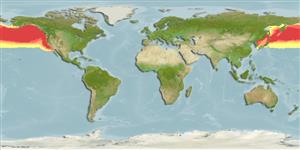Environment: milieu / climate zone / depth range / distribution range
Ecology
Marine; bathypelagic; depth range 31 - 3400 m (Ref. 50550), usually 31 - 1189 m (Ref. 4925). Deep-water; 66°N - 29°N, 128°E - 113°W
North Pacific: Japan to Bering Sea and to northern Baja California, Mexico.
Size / Weight / Age
Maturity: Lm ? range ? - ? cm
Max length : 13.0 cm TL male/unsexed; (Ref. 2850); max. reported age: 8 years (Ref. 6885)
Dorsal
spines
(total): 0;
Dorsal
soft rays
(total): 13-15;
Anal
spines: 0;
Anal
soft rays: 14 - 16;
Vertebrae: 35 - 38. Adipose fin small and slender; pectorals slender and short (Ref. 6885). Gray to dark greenish blue on dorsally, lighter ventrally; black on operculum and fins; golden or claret on photophores (Ref. 6885). Branchiostegal rays: 9-10 (Ref. 31442).
Epipelagic to mesopelagic (Ref. 31442). Adults move upward in large numbers at night (Ref. 28499). Feed on fishes, copepods and euphausiids (Ref. 11712). Oviparous, with planktonic eggs and larvae (Ref. 31442). Lipid content is 15.6 % in fresh body weight and wax ester is 90.9 % in total lipids (Ref. 9197). Minimum depth from Ref. 82347.
Eschmeyer, W.N., E.S. Herald and H. Hammann, 1983. A field guide to Pacific coast fishes of North America. Boston (MA, USA): Houghton Mifflin Company. xii+336 p. (Ref. 2850)
IUCN Red List Status (Ref. 130435)
Threat to humans
Harmless
Human uses
Tools
Special reports
Download XML
Internet sources
Estimates based on models
Preferred temperature (Ref.
123201): 0.9 - 7.4, mean 3.4 °C (based on 877 cells).
Phylogenetic diversity index (Ref.
82804): PD
50 = 0.7500 [Uniqueness, from 0.5 = low to 2.0 = high].
Bayesian length-weight: a=0.00955 (0.00414 - 0.02201), b=3.07 (2.86 - 3.28), in cm total length, based on LWR estimates for this species & (Sub)family-body (Ref.
93245).
Trophic level (Ref.
69278): 3.1 ±0.0 se; based on diet studies.
Resilience (Ref.
120179): Medium, minimum population doubling time 1.4 - 4.4 years (K=0.24-0.34; tm=4; tmax=8).
Fishing Vulnerability (Ref.
59153): Low to moderate vulnerability (33 of 100).
Nutrients (Ref.
124155): Calcium = 67 [20, 203] mg/100g; Iron = 0.523 [0.197, 1.651] mg/100g; Protein = 16.9 [15.0, 18.7] %; Omega3 = 0.529 [0.179, 1.535] g/100g; Selenium = 16 [5, 48] μg/100g; VitaminA = 77.8 [10.3, 643.1] μg/100g; Zinc = 0.755 [0.380, 1.665] mg/100g (wet weight);
